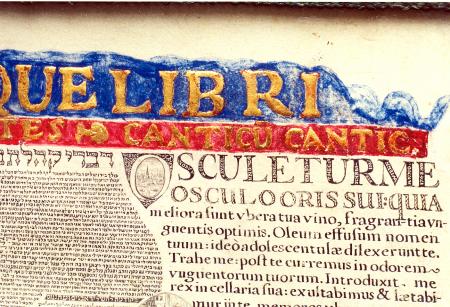Obj. ID: 26146
Hebrew Illuminated Manuscripts Herlingen's Five Scrolls, Vienna, 1748

The sheet with the Five scrolls belongs to a group of works carried out (among others) in Vienna by the scribe and illuminator Aaron Ben Binyamin Wolf (Ze'ev) Herlingen from Gewitsch (Moravia; c.1700 - c.1760), of which until now five similar compositions, including our sheet, are known. All of them are written in Vienna, the earliest of which is written in 1733 (ÖNB Cod. S.n. 1594; Cat. No. # - pp. #-#). Two other sheets, which were written in the same year as our sheet (1748), are in theIsraelMuseuminJerusalemand in the Royal Library at Stockholm(see K. Schubert, 1991, p. 35 and fig. 6). The last one is from the year 1755 (also signed 1752), in the Richard D. Levy Collection inNew York, formerly in the Sassoon Collection.
Herlingen is a well-known scribe and illuminator, who worked most of the time in Viennabut also in Pressburg. In the colophon of our sheet, he calls himself "Aaron Wolf, the Imperial and Royal Library Scribe in Vienna", a title he already received around 1736 (Sabar, "Seder Birkat ha-Mazon, p. 468) Today, close to fifty works are attributes to him. Among them are Esther scrolls, Psalms, various small prayer books and mainly Passover Haggadot. The earliest known manuscript by him is Seder Birkat ha-Mazon, copied in Vienna in 1719/20 (Private Collection; Sabar, Seder Birkat haMazon, p. 468). For more details on his life and work, see the remarks in Herlingen's Five Scrolls of 1733 (ÖNB Cod. S.n. 1593; Cat. No. # - pp. #-#).
The style and composition of the miniatures in this sheet differs clearly from his illustrations of 1733. Compare for instance the sketchily drawn figures in our sheet to the clear contours and the fully detailed figures in the sheet of 1733. Differences in details of the figures are clear particularly in illustrations with similar compositions, for example, in "Solomon's Judgment", where the woman on the left is hardly seen and the soldier is depicted with his head detached from his body, or in the illustration of "Solomon handing King Solomon handing down a piece of paper", where Solomon is depicted with one leg.
Herlingen also used different iconography to the same themes. In the illustration of the book of Ruth in our sheet, for instance, he preferred to illustrate another moment in the story of Ruth and Boaz. In contrary to that of 1733, Ruth in our sheet is not speaking to Boaz and the servant is not in the picture. However, the iconography of our sheet is much more similar to that of Sassoon sheet of 1755 (Richard D. Levy Collection inNew York).
The change of style in our sheet may be due to Herlingen's older age when probably his hands and eyes weaken. However, in these years he continued to produce micrographic works such as the two similar sheets from the same year (the Israel Museum in Jerusalem and in the Royal Library at Stockholm, see above), and in 1752 he made a portrait in micrography of Louis XV, King of France and Navarra (Catalogo Orsini Arte e Libri, p. 42), therefore It seems, that the different composition and figures might be explained by other models that Herlingen used. The differences in style can be explained by Herlingen's artistic development and by the other hand of his assistance as is evident for instance in Seder Tikkunei Shabbat, written in Pressburg in 1727, presumably by Aaron Wolf Herlingen's pupil and now held in the Austrian National Library, Cod. hebr. 130 (Cat. No. #, pp. #, pp. #).
sub-set tree:
: One sheet of parchment.
Measurements
|
Full page: ca. 300 X220 mm |
|
Text space: ca. 242 X117 mm |
Scribes
Single
Script
Main text: in square, semi-cursive and cursive tiny script (micrography) in four languages, Hebrew, French, German and Latin, in light brown ink.
Headings and some of the text: in decorated display script.
Number of columns
Various numbers of columns
Number of lines
Various numbers of lines
Ruling
Ruling on lines and lines.
Pricking
(e.g. fols. )
Quires
Not relevant
Catchwords
Not relevant
Hebrew numeration
Not relevant
Blank leaves
The verso side of the leaf is blank?
The text of the Five scrolls is written in shaped text in micrography forming over the sheet a symmetrical composition of a stylized tree with branches (whole page). The text is in brown ink and decoration in sepia of the same tonality. The decorated Latin title of the sheet HICSUNT QUINQUE LIBRI ("… Five Books") is written in burnished gold display letters on a blue ground. Each scroll is titled with the Latin name of the book written in smaller display script in burnished gold letters on a red ground. Each scroll opens with a Latin title written in display script filled with geometrical and floral motifs in spared ground technique.
The decoration in the text includes:
- Five text illustrations each within a bell-shaped cartouche, are integrated into the micrography text, three on top and two at the bottom of the sheet, as follows: King Solomon handing down a piece of paper (top right); Solomon's Judgment (top center); Ruth and Boaz (top left); Ahasuerus listening to the Book of Records, Haman leading Mordecai (bottom right) Esther and Mordecai in front of Ahasuerus, and Hanged Haman's ten sons on a gallows (bottom left).
- Two initial letters for the books of Ruth and Song of Songs (landscape ofVienna).








